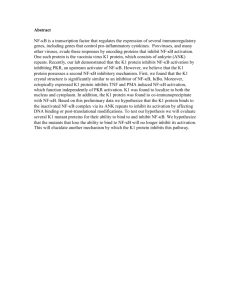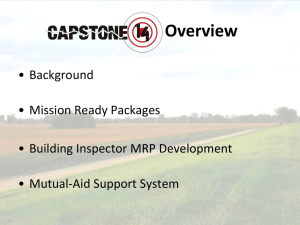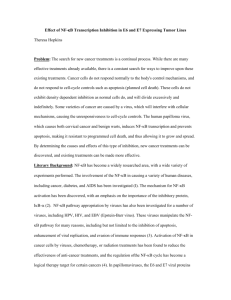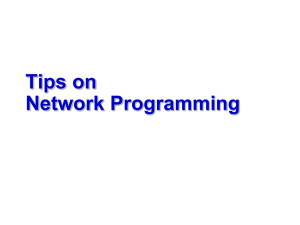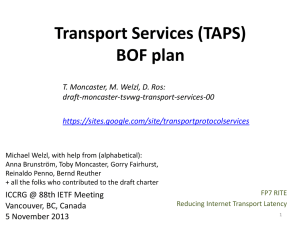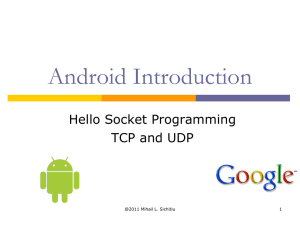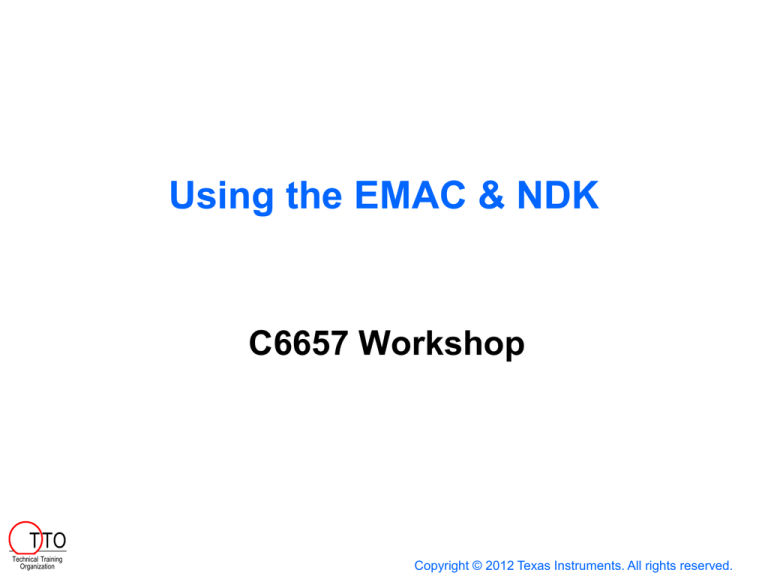
Using the EMAC & NDK
C6657 Workshop
T TO
Technical Training
Organization
Copyright © 2012 Texas Instruments. All rights reserved.
Outline
T TO
Technical Training
Organization
Introduction to Networking
EMAC Architecture Overview
Network Development Kit (NDK)
Client.pjt – Your “StarterWare”
Sockets Programming
Client-Server Paradigm
Typical network app has two pieces:
client and server
Client
Server
browser
www.cnn.com
• Initiates contact w/server
• Provides requested service
to client
• Speaks first
• Sends requested data
(e.g. web page)
• Requests service/data from server
6657
6657
EMAC
T TO
Technical Training
Organization
PHY
PHY
EMAC
Networking Overview
What is a network?
“A set of data processing nodes that are interconnected
for the purpose of data communication.”
What is a protocol?
“A set of rules and conventions about the communication
in the network: e.g. data format, interpretation, timing.”
What problem are we trying to solve?
Send DATA across a network – any protocol can be used (and there are many)
The “physical” layer can be anything (cables, satellite, wireless, etc.). This layer will
conform to some standard (e.g. 802.11 wireless, 802.3 wired, etc.)
Networking can be split into multiple “layers”:
• MPEG
• HTTP
• MPEG
• HTTP
App
App
Protocol Stack
Protocol Stack
• Data
Format
EMAC
EMAC
• Data
Format
• Physical
Network
PHY
PHY
• Physical
Network
• TCP
• UDP
• TCP
• UDP
TCP/IP Implementation
The TCP/IP model is a layered abstract description for communications and
computer network protocol design, created in the late 1970s by DARPA.
TCP/IP defines the internet’s protocols and structure. It has fewer, less rigidly
defined layers than the OSI model – an easier fit for real-world protocols.
Let’s compare the OSI model to the TCP/IP model:
OSI Model
TCP/IP Model
App
Presentation
• SMTP
App
• FTP
Session
T TO
Technical Training
Organization
• HTTP
Transport
Transport
Network
Network
• IP (Internet Protocol Address)
Data
Data
• EMAC (Ethernet, 802.11, etc.)
Physical
Physical
• TCP (Transmission Control Protocol)
• PHY (Ethernet, SCSI, hubs, repeaters, cables)
Let’s review some terms and definitions…
Networking – Terms and Definitions
Packet
• a formatted block of data carried by a network consisting of 3 elements: header (beginning),
data (or payload), trailer (which contains the checksum for error checking)
MAC Address
• an identifier attached to most network
adapters (NICs). A number that acts like
a name for a particular network adapter.
Client/Server APPLICATION
Voice/Video
MPEG
IP Address
• a unique logical address used to identify and
communicate over on a computer network
(a computer address)
Data
H.264
FTP
SOCKET
Port
• a special number present in the header of a
data packet used to map data to a process.
If IP = city block, port = house number.
Socket
• an intelligent buffer that connects the app to
the transport layer. Can be implemented over
any transport protocol (most popular types
are: Datagram (UDP) and Stream (TCP).
T TO
Technical Training
Organization
HTTP
Port
IP
Address
TCP
UDP
TCP/IP
“Stack”
IP
MAC EMAC
Address
What data does an Ethernet packet contain?
PHY
Packet
Ethernet Frame
An Ethernet Packet is comprised of the following:
• Ethernet Header
• Data
Destination MAC Address
Source MAC Address
Length
# Bytes
7
Preamble
1
6
SFD Destination
6
2
Source
Len
46-1500
Data
IP
TCP
HDR HDR
T TO
Technical Training
Organization
Application Data
4
FCS
Outline
T TO
Technical Training
Organization
Introduction to Networking
EMAC Architecture Overview
Network Development Kit (NDK)
Client.pjt – Your “StarterWare”
Sockets Programming
Master
M
SCR – EMAC
Slave
EDMA3
TCP2
TC0
TC1
CC
TC2
TC3
VCP2
SCR = Switched Central Resource
McBSP
PCI
Utopia
DDR2
EMAC
HPI
PCI
L1P
C64x+ MegaModule
EMIF
L2
Mem
Ctrl
L2
SRIO
S
M
DATA
SCR
128
128
32
S
M
External
Mem
Cntl
S
M
IDMA
L1P
Mem
Ctrl
CPU
PERIPH
AET
D
S
M
L
M
Cfg
D
S
M
L
L1D
Mem
Ctrl
L1D
EMAC is a master on the DATA SCR (can initiate a transfer to anywhere – has its own DMA)
TX and RX connect to the DATA SCR
Config registers and descriptor memory located on CFG SCR
S
PERIPH =
All peripheral’s
Cfg registers
32
S
CFG
SCR
Serial Gigabit (SGMII)
C6657 EMAC supports the SGMII interface:
• SGMII – Serial Gigabit Media Independent Interface (1-bit data, 10/100/1000 Mbps)
EMAC: data interface between PHY and system core (clk, control, data)
MDIO: used to interrogate/control Ethernet PHY
T TO
Technical Training
Organization
How does the EMAC work?
EMAC Module
EMAC module interfaces the PHY components through the Serial Gigabit Media Independent
Interface (SGMII) and system core via the EMAC control module.
RX path: PHY, MAC receiver, FIFO, DMA engine, EMAC control module
TX path: EMAC control module, DMA engine, FIFO, MAC transmitter, PHY
Also includes statistics, state RAM, interrupt controller, control regs/logic, clock/reset logic
Data
SCR
T TO
Technical Training
Organization
PHY
Outline
T TO
Technical Training
Organization
Introduction to Networking
EMAC Architecture Overview
Network Development Kit (NDK)
Client.pjt – Your “StarterWare”
Sockets Programming
TI’s NDK Implementation
As you can tell, the EMAC is a complex peripheral with MANY registers to properly
configure in order to transmit/receive data.
Solution? The Network Development Kit (NDK). You can think of the NDK as a
networking O/S for the EMAC (similar to DSP/BIOS being an O/S for the DSP).
Earlier, we saw the TCP/IP implementation of the OSI model. How does TI’s NDK
compare to the TCP/IP model?
TCP/IP Model
App
NDK Model
App
Transport
Network
T TO
Technical Training
Organization
• PPP
• DNS
• PPPoE
• many others
• Sockets Programming Services
NDK/EMAC
• Internal stack functions
• Configures stack/services
and configures the EMAC
Data
Physical
• HTTP
• TFTP
• Telnet
• DHCP
Physical
So, what does the NDK contain
and how much does it cost?
Network Development Kit (NDK)
NDK is a set of libraries + example code that properly initialize/configure/operate
the hardware (EMAC) and perform all of the TCP/IP functionality through a set of
“socket” programming APIs (e.g. socket, bind, send, recv, etc.)
$5K one-time licensing fee
Provides a seamless interface to the physical layer (EMAC/PHY)
NDK Model
App
• HTTP
• TFTP
• Telnet
• DHCP
• PPP
• DNS
• PPPoE
• many others
• Sockets Programming Services
NDK/EMAC
• Internal stack functions
• Configures stack/services
and configures the EMAC
Physical
T TO
Technical Training
Organization
What does the user touch?
• Configuration
Do you know all of the details
of what is going on underneath ?
• Nope
Do you care ?
• Maybe…
Would you like to load an
example and play with it ?
• Of course…we’ll do that
in the upcoming lab…
Where can you purchase the NDK?
Where to Find the NDK
Part of MCSDK 2.0.9 (available early June 2012)
• Search the TI Embedded Processors Wiki at:
http://processors.wiki.ti.com
T TO
Technical Training
Organization
Installing the NDK
Install MCSDK 2.0.9 or later
T TO
Technical Training
Organization
Let’s take a look at one of the examples built around the NDK…
Outline
Introduction to Networking
EMAC Architecture Overview
Network Development Kit (NDK)
Client.pjt – Your “StarterWare”
Sockets Programming
T TO
Technical Training
Organization
Client.pjt Example - Overview
Client.pjt is an NDK example project that is a complete
system that uses several servers/services available to
the developer.
Key Source Files
Client.c
• Main function and all the initialization/configuration routines in the
main stack function [ StackTest() ]
• Callback functions like NetworkOpen() and NetworkClose() that
initialize/kill all user application tasks.
• Other callback functions like NetworkIPAddr() and CheckDHCPOptions()
that provide feedback regarding the connection status.
Console (console.c, and all com???.c files)
• Console application that is used by the telnet service
Servers (datasrv.c, echosrv.c, oobsrv.c, nullsrv.c, newservers.c)
• Embedded servers in the NDK client example
HTTP (webpage.c, cgiparse.c, cgiparsem.c)
• internal web page used by the http service and cgi interpreter
Client.pjt – What Does It Contain?
When you purchase the NDK, you get several examples. The key example
that you can modify is client.pjt. So, it is thrown in your lap…now what?
The question is: what do we need to keep and what can we delete? Remember,
our goal is to receive a packet and echo it back.
Let’s first look at what the client project contains:
Client.pjt contains
• DSP/BIOS .tcf file
• Include Files
• Libraries
• Source Files
• Command File (.cmd)
Note: client.pjt contains client
AND server software
T TO
Technical Training
Organization
What do the different libraries do
and which ones can we delete?
Client.pjt - Libraries
The NDK Libraries are where all of the work gets done. When you call an API
in source code, it will activate one or several of these libraries to perform the
requested operation and properly configure/run the EMAC hardware.
HAL??.lib (Hardware Abstraction Layer)
• Interfaces the hardware peripherals to the NDK
• Including timers, LED indicators, ethernet devices, serial ports.
MINIPRINTF.lib
• Provides small-footprint printing functions
NETCTRL.lib
• This is the MANAGER of the stack. It controls interaction
between the TCP/IP stack and the outside world
NETTOOL.lib
• Contains all sockets-based network services + a few add’l
tools to aid in developing network applications
OS.lib
• Adaptation layer that maps O/S function calls to DSP/BIOS
function calls. Includes thread mgmt, mem allocation, packet
buffer mgmt, printing, logging, sections, cache coherency
T TO
Technical Training
Organization
STACK.lib
• Main TCP/IP networking stack. Contains everything from the
socket layer at top to the Ethernet/PPP layers at bottom.
So, which libraries can we delete? None. They are all important. Now, let’s discuss sockets programming…
Outline
Introduction to Networking
EMAC Architecture Overview
Network Development Kit (NDK)
Client.pjt – Your “StarterWare”
Sockets Programming
T TO
Technical Training
Organization
What is a Socket?
Applications run on the client and the server
How does the application program the lower layers?
Either manually or via SOCKETS PROGRAMMING…
Client/Server APPLICATION
“Application
Layer”
Voice/Video
MPEG
H.264
Socket
• Network Development Kit
“Transport
Layer”
• If you’ve done sockets
“Network
Layer”
(NDK) provides standard
sockets programming services
programming before, all the APIs
will be familiar to you
• Reference: SPRU524
T TO
Technical Training
Organization
FTP
SMTP
HTTP
DNS
SOCKET
• An intelligent buffer that connects
the application to the transport
layer.
Data
TCP
UDP
TCP/IP
“Stack”
IP
“Data
Layer” EMAC
“Physical
Layer”
PHY
Packet
TCP Sockets Programming – APIs
“open a socket”
“sets IP addr & port
number of server”
Server
Client
socket()
socket()
bind()
“wait, listen, until it rcvs
correct IP/port addr”
listen()
“accept request”
accept()
“send data”
“response rcvd”
send()
recv()
close()
T TO
Technical Training
Organization
PKT
XFR
connect()
“connect to server
IP address”
recv()
“rcv & process pkt”
send()
“send responses”
close()
TCP – “connected”, uses handshaking to make sure the data was received – slower, but reliable
TCP – Application Example (Echosrv.c)
Server that echos back the data to the client
To build this application, we need 3 major parts (stack startup/init, BIOS TSK,
and a file descriptor environment)
LAYERS
APP
CLIENT.C (STACK CFG/INIT)
TCP UDP
EMAC
.I.P.
PHY
SKT
// Declarations
// Stack Startup – StackTest()
TCP UDP
NC_SystemOpen( )…
.I.P.
Cfg Services (echo)…
NC_NetStart (hCfg, …)…
EMAC
// Create BIOS TSK for echo
hEcho = TaskCreate (echosrv,…);
PHY
…
ECHOSRV.C (APP)
APP
FD Environment
BIOS TSK
void echosrv() {
// Declarations
// Prologue
fdOpenSession();
stcp = socket(…);
bind (stcp, …);
listen (stcp, …);
// Loop
FD_SET (stcp, &ibits);
fdSelect (.., &ibits, …);
accept (stcp, …);
recvnc (x);
send (x); //echo x
ibits
stcp
sudp
..
SKT
stcp
SKT
sudp
• Client.c is responsible for configuring services, stack startup and creating the TSK
• Echosrv.c is a BIOS TSK that creates/inits the socket and FD environment for
T TO using sockets programming APIs (e.g. socket, bind, listen, etc.)
Technical Training
Organization
How is UDP different?
UDP Sockets Programming – APIs
“open a socket”
Server
Client
socket()
socket()
“sets IP addr & port
number of server”
bind()
“receive data from…”
recvfrom()
sendto()
“send data to…”
PKT
XFR
“send data to…”
sendto()
recvfrom()
“receive data from…”
UDP – no handshaking, fewer APIs, easier to program – faster, but unreliable
T TO
Technical Training
Organization
Let’s compare UDP and TCP…
Sockets Programming – TCP vs. UDP
In general, these two protocols do the same thing – send data.
However, their implementation, reliability, speed and usefulness
in specific applications vary widely.
Let’s compare each protocol from a high level…
TCP
UDP
Connection
• Connected communication protocol
• Uses handshaking between hosts
• Guarantees reliability of delivery
• No such mechanism
• No handshaking
• Less reliable (fire and forget)
Speed
Slower
Faster
Socket APIs
Connected: uses connect(), accept(),
listen() APIs
Does not use connect(), accept()
listen() APIs
Send/Rcv
Uses send() and recv() APIs to the
bounded address/port combo
Uses sendto() and recvfrom() APIs
where src/dst addr must be specified
Applications
Used in apps that require absolute
reliability (financial info, etc.)
Used in apps that don’t care about
reliability and speed is critical
(e.g. streaming web audio/video)
T TO
Technical Training
Organization
Let’s look at some key considerations when using the NDK for the first time…
NDK Considerations
Most of the following is contained in the NDK User Guide (SPRU523).
However, it is a useful list of “pointers” to information that may
help your initial out-of-box experience with the NDK:
Library descriptions (SPRU523, Sec 1.3)
Explanation of the NDK software directory structure (SPRU523, Sec 1.3.3)
NDK Initialization and Configuration (SPRU523, Sec 3.3)
HAL drivers assume some L2 cache is configured (SPRAAQ5)
Stack size recommendations (UDP/TCP stack sizes, SPRU523, Sec 3.2.2.1)
Choosing TSK priorities (SPRU523, Sec 3.2.2.2)
I am getting “this” error – what do I do now? (SPRU523, Sec 3.4)
Packet buffers are allocated in a memory section called NDK_PACKETMEM
configurable by the user (SPRU523, Sec 3.1.4)
Use client.pjt as your starting point for your application (many “uh oh’s”
can be avoided following this simple advice vs. starting with a blank page)
T TO
Technical Training
Organization
For more information…
For More Information…
Shown below are references that you can use to learn more
about networking, the NDK and the EMAC:
• User Guides and Application Notes:
NDK User Guide – SPRU523
NDK Programmer’s Guide – SPRU524 (all the API calls are listed here)
EMAC User Guide – SPRU975
Using IP Multicasting with the TMS320C6000 NDK – SPRAAI3
• Useful Textbooks:
UNIX Network Programming – vol 1 (The sockets and networking API).
Stevens, Richard W.; Fenner, Bill; Rudoff, Andrew M. Third Edition.
TCP/IP Illustrated – vol 1 (The protocols). Stevens, Richard W.
TCP/IP Protocol Suite. Forouzan, Behrouz A.
• Internetworking Technology Handbook (CISCO Systems)
www.cisco.com/univercd/cc/td/doc/cisintwk/ito_doc/index.htm
T TO
Technical Training
Organization
TI NDK Support: softwaresupport@ti.com

